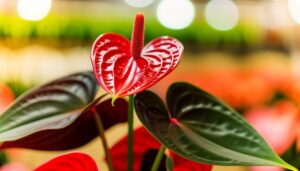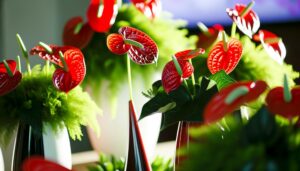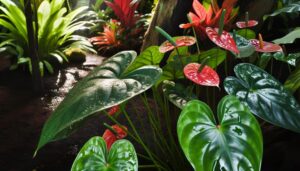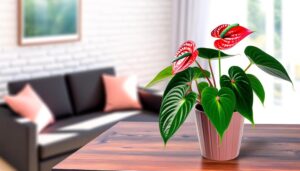Caring for Anthurium Red Stem Plants
To care for Anthurium Red Stem plants, provide bright, indirect light and avoid direct afternoon rays. Water thoroughly, allowing the top inch of soil to dry between waterings, and keep humidity between 60-80%.
Use a well-draining soil mix with good aeration and slightly acidic pH. Maintain temperatures between 70-85°F without sudden fluctuations.
Fertilize with a balanced, water-soluble fertilizer diluted to half strength every four to six weeks. Look for vibrant, lush leaves as an indicator of proper care.
By following these guidelines, you'll ensure prime growth and health, and there's much more to learn about these stunning plants.
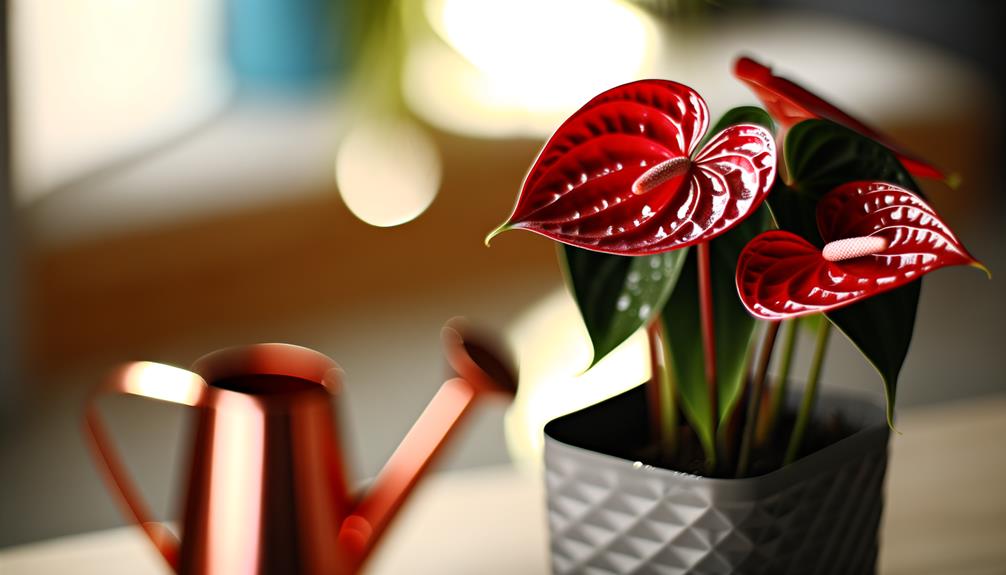
Key Takeaways
- Place in bright, indirect light and avoid direct afternoon sun.
- Water thoroughly, allowing the top inch of soil to dry between waterings.
- Use well-draining soil and maintain slightly acidic pH.
- Keep temperature between 70-85°F and humidity levels at 60-80%.
- Fertilize with diluted, balanced fertilizer every four to six weeks.
Ideal Light Conditions
Anthurium red stem plants thrive most in bright, indirect light, which promotes ideal photosynthesis without causing leaf burn. Positioning your plant near an east-facing window guarantees it receives ample morning sunlight, diffused by sheer curtains.
You'll want to avoid direct afternoon rays, as they can be too intense and result in photodamage. If natural light is insufficient, consider using full-spectrum grow lights to mimic the best light conditions. Make sure the light source is placed at a distance that replicates indirect sunlight.
Monitor the leaf color and growth rate as indicators of proper light exposure. Pale leaves suggest insufficient light, while scorched edges indicate overexposure. By fine-tuning these conditions, you'll optimize your anthurium's growth.
Watering Routine
Making sure your anthurium red stem plant receives the right amount of water is as crucial as providing ideal light conditions. You'll want to water thoroughly until water drains from the pot's bottom, then wait until the top inch of soil feels dry before watering again. Stick to a consistent schedule, adjusting based on seasonal changes and indoor humidity levels.
| Watering Frequency | Description |
|---|---|
| Weekly | During active growth (Spring/Summer) |
| Bi-weekly | Dormant period (Fall/Winter) |
| Humidity Needs | 60-80% relative humidity |
High humidity is essential for optimal growth. Use a humidity tray or a room humidifier if necessary. Overwatering can lead to root rot, while underwatering stresses the plant. Monitoring soil moisture and environmental humidity will help your anthurium thrive.
Soil Preferences
For best growth, you should use a well-draining soil mix that includes components like peat, pine bark, and perlite.
Ensuring good drainage and aeration is essential to prevent root rot and allow air circulation around the roots.
The ideal soil composition maintains a balance of moisture retention and excess water runoff.
Ideal Soil Composition
To achieve top growth, you should use a well-draining, aerated mix rich in organic matter for your Anthurium Red Stem plants. This ensures peak root health and nutrient uptake.
Start with equal parts orchid bark, perlite, and peat moss. Orchid bark provides structural strength and promotes drainage. Perlite enhances aeration, preventing root decay. Peat moss retains moisture while supplying organic nutrients. Adding a small amount of charcoal can help absorb impurities and maintain soil freshness.
Incorporate a slow-release fertilizer to provide essential nutrients over time. Regularly check the pH, aiming for a slightly acidic range of 5.5 to 6.5. By crafting this precise blend, you'll create a thriving environment where your Anthurium Red Stem can flourish.
Drainage and Aeration
Best drainage and aeration are important for the health of your Anthurium Red Stem, ensuring that the roots receive sufficient oxygen and excess water is efficiently expelled. Use a well-draining mix, incorporating components like orchid bark, perlite, and peat moss. These materials create air pockets, preventing root rot by ensuring moisture doesn't stagnate around the roots.
Monitor the moisture level consistently; the soil should be damp but not waterlogged. Opt for pots with drainage holes to facilitate excess water escape. Additionally, occasional soil aeration using a small tool can enhance oxygen flow to the roots.
Proper drainage and aeration are vital to preventing fungal infections and promoting robust growth in your Anthurium Red Stem.
Temperature and Humidity
To achieve best growth for your Anthurium Red Stem plants, maintain a temperature range of 70-85°F (21-29°C).
It's essential to sustain humidity levels between 60-80% to replicate their native tropical environment.
Using a humidifier or placing the plant on a pebble tray with water can help achieve these conditions.
Ideal Temperature Range
Maintaining a recommended temperature range of 65-80°F (18-27°C) is crucial for the healthy growth of Anthurium Red Stem plants. You should monitor the ambient temperature closely, as deviations can stress the plant.
Below 60°F (15°C), the plant's metabolic processes slow considerably, leading to stunted growth. Conversely, temperatures above 85°F (29°C) can cause leaf scorching and hinder photosynthesis.
Guarantee your plant's environment remains within this ideal range by using a reliable thermometer. Sudden temperature fluctuations are especially harmful; avoid placing your Anthurium near drafty windows or heating vents.
A stable temperature maintains cellular functions, nutrient uptake, and overall health, ensuring your Anthurium Red Stem thrives.
Maintaining Proper Humidity
While maintaining the temperature remains stable, it's equally important to monitor and maintain the humidity levels around your Anthurium Red Stem plant. Best humidity levels should range between 60-80%. Low humidity can lead to leaf browning and poor growth. You can use a hygrometer to accurately measure the moisture in the air. If needed, employ a humidifier or place a tray of water near the plant to increase humidity. Regular misting is also beneficial.
Below is a quick reference table:
| Humidity Level | Action Required | Tools Needed |
|---|---|---|
| <60% | Increase humidity | Humidifier, water tray |
| 60-80% | Maintain current conditions | Hygrometer |
| >80% | Decrease humidity slightly | Dehumidifier |
Proper humidity care ensures your plant thrives.
Fertilizing Tips
When fertilizing Anthurium red stem plants, use a balanced, water-soluble fertilizer with a ratio of 20-20-20 to guarantee optimal nutrient uptake. Dilute the fertilizer to half the recommended strength to prevent root burn.
Administer this solution every four to six weeks during the growing season, typically from spring to early fall. Confirm the soil is moist before applying the fertilizer to boost absorption and reduce stress on the plant.
Pay close attention to the foliage; vibrant, lush leaves indicate adequate nutrient levels. Over-fertilization can lead to salt buildup, which stresses the roots and hampers growth.
Common Issues and Solutions
To address common issues with Anthurium red stem plants, start by identifying symptoms such as yellowing leaves, stunted growth, or root rot, which often point to specific underlying problems. Yellowing leaves typically indicate over-watering or nutrient deficiencies. Stunted growth may result from insufficient light or poor soil quality. Root rot is usually due to waterlogged soil.
| Symptom | Potential Cause | Solution |
|---|---|---|
| Yellowing Leaves | Over-watering | Reduce watering frequency |
| Nutrient Deficiencies | Apply balanced fertilizer | |
| Stunted Growth | Insufficient Light | Move to a brighter location |
| Poor Soil Quality | Use well-draining soil mix | |
| Root Rot | Waterlogged Soil | Repot with improved drainage |
Conclusion
To sum up, caring for your anthurium red stem plant involves consistent conditions and careful consideration. Guarantee it enjoys indirect light, maintains moist soil, and thrives in warm, humid environments.
Feed it with a balanced fertilizer and address any ailments promptly. By providing precise parameters and persistent attention, you'll promote prolific growth and vibrant blooms.
Perfect your plant practices, and your anthurium will flourish, featuring fantastic, fiery foliage. Follow these focused steps, and your plant will thank you.

